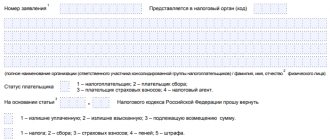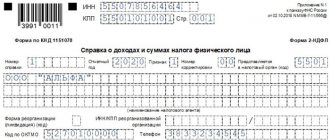Land use in the country is regulated by land legislation, and the conditions for calculating the tax for land use are dictated by the Tax Code of the Russian Federation. But, since this tax is local, the Tax Code of the Russian Federation gives general interpretations, establishing tax rates for land tax and defining groups of payers, as well as the conditions for providing benefits. Funds from the payment of the tax go to the budgets of municipalities, and therefore regions are given the right, based on territorial characteristics, to designate the rates, terms and conditions for transferring payments. Our publication will answer the questions of who sets land tax rates and how to determine the tax rate for land tax.
Tax Code: land tax, rates
The land tax rate is the most important element in tax calculation. Art. 394 of the Tax Code of the Russian Federation determines the highest rates for lands for various purposes. Thus, the land tax rate of 0.3% of the value according to the cadastre is applied to lands used:
- for gardening/vegetable gardening, summer cottage farming;
- agricultural purposes;
- for housing stock or purchased for housing construction;
- by the state in order to ensure the country’s defense capability and the needs of customs.
For other plots, the land tax rate is 1.5% of their value per year.
So, the interest rate on land tax in 2021 has not changed and is still between 0.3 and 1.5%.
Tax rates for land tax
They are established by the constituent entities of the Russian Federation within the limits of the rates prescribed in the Tax Code of the Russian Federation. The rates recommended by the Tax Code of the Russian Federation are maximum. Specific rates of land tax are established by the laws of the power structures of municipalities, and often their values differ markedly from those recommended by the Tax Code of the Russian Federation. Regional authorities have the right to approve basic land tax rates , changing them in accordance with the territorial and economic characteristics of the region. Here are examples of applicable tax rates.
Tax base and procedure for its determination
The tax base (TB) of those agricultural land plots that are recognized as an object of taxation is determined on the basis of their cadastral value. The latter, in turn, is determined by the land legislation of the Russian Federation (Article 390 of the Tax Code of the Russian Federation). The starting point for the calculation is the cadastral value as of January 1 of the year that is the tax period. If the land plot was formed later, when the tax period has already begun, then its tax base is determined by the cadastral value as of the day the necessary data about it (the plot) was entered into the Unified State Register.
If an agricultural plot is located simultaneously on the territory of several municipalities, then its tax base is calculated according to the following principle:
- The tax base is determined for each municipality separately.
- The cadastral value of the entire land plot is determined for each municipality.
- The share of the cadastral value is calculated in proportion to the territory that is located in a given municipality.
- Based on the resulting result, the tax base is calculated.
If the cadastral value changes during the tax period, then this is not reflected in any way on the tax base of the current and previous tax periods. However, if such a value was determined incorrectly, then the tax base will be changed, and these changes will be applied to all tax periods for which the tax on agricultural land was calculated.
If the right of common ownership is established for a land plot, then the tax base is determined for each taxpayer separately, according to his share. Legal entities determine the tax base on the basis of the Unified State Register independently, for individuals - this function is performed by the tax authorities on the basis of information provided by the authorities that carry out state cadastral registration (Article 391 of the Tax Code of the Russian Federation).
For whom the tax base can be reduced
According to the Tax Code of the Russian Federation, the NB reduction by 10,000 rubles (the amount is not taxed) for the following categories of citizens:
- Heroes of the USSR and the Russian Federation, full holders of the Order of Glory;
- disabled people since childhood, as well as groups I and II;
- veterans and disabled people of the Second World War and combat operations;
- persons affected by radiation at the Chernobyl Nuclear Power Plant, the Mayak production association, and the Semipalatinsk test site, and who are entitled to receive social support in accordance with federal laws;
- participants in tests of nuclear installations, liquidation of accidents at nuclear installations, who acquired diseases as a result and became disabled.
If the amount of 10,000 rubles exceeds the tax base, then the latter is equal to zero (Article 391 of the Tax Code of the Russian Federation).
Land tax rate in Moscow for 2021:
| Type of land plot | Land tax rates in 2021 |
| Land plots provided for private farming, gardening, vegetable farming or livestock farming, as well as summer cottage farming/dacha construction, including lands related to common property | 0,025% |
| Land plots occupied by parking lots for long-term storage of personal vehicles and multi-story parking garages | 0,1% |
| Land plots occupied by the housing stock and engineering infrastructure facilities of the housing and communal complex (except for the share in the right to a plot pertaining to an object not related to the housing stock and engineering infrastructure facilities) or provided for housing construction | |
| Land plots classified as lands within agricultural use zones in the city of Moscow and used for agricultural production | 0,3% |
| Land plots provided and used for the operation of sports facilities, incl. sports facilities | |
| All other land plots | 1,5% |
Land tax rates in St. Petersburg for 2021 are more variable:
| Type of land plot | Land tax rates in St. Petersburg |
| Land plots acquired/provided for personal subsidiary plots, gardening, vegetable farming or livestock farming, as well as summer cottage farming | 0,042% |
| Land plots with type of permitted use: - “for fishing”; — “for the placement of parking lots with box-type garages”; — “to accommodate garages for vehicles of disabled people”; — “for the placement of parking lots for public transport (departmental, excursion transport, taxis)”; — “for the placement of parking lots for external freight transport”; — “for the placement of berths and parking lots for water transport.” | |
| Land plots occupied by the housing stock and engineering infrastructure facilities of the housing and communal complex (except for the share in the right to a plot attributable to an object not related to the housing stock and engineering infrastructure facilities) or acquired/provided for housing construction | 0,01% |
| Land plots with the type of permitted use “for the placement of multi-storey and underground garages” | |
| Land plots classified as lands within agricultural use zones in populated areas and used for agricultural production | 0,3% |
| Land plots with permitted use “for recreational purposes” | |
| Land plots with the type of permitted use “for parking of individual passenger vehicles” | 0,42% |
| Land plots with type of permitted use: — “for the placement of educational facilities”; — “for the placement of facilities for preschool, primary and secondary general education”; — “for the placement of secondary and higher vocational education facilities”; — “for the placement of healthcare and social security facilities”; — “for the placement of hospital facilities”; — “for the placement of hospital institutions without special requirements for placement”; — “for the placement of hospital institutions with special requirements for placement (such as infectious diseases, etc.)”; — “for the placement of outpatient clinics”; — “for the placement of medical laboratories, ambulance and emergency aid stations, sanitary and epidemiological service institutions, forensic medical examination institutions and other similar facilities”; — “for the placement of sanatorium and resort institutions”; — “for the placement of social security facilities”; — “for the placement of physical culture and sports facilities”; — “for the placement of indoor sports complexes with stands for spectators with a number of seats up to 1 thousand”; — “for the placement of indoor sports complexes with stands for spectators with a number of seats over 1 thousand”; — “for the placement of sports clubs”; — “for the placement of yacht clubs and water sports facilities”; — “for the placement of open planar physical education and sports facilities.” | 0,06% |
| Land plots with type of permitted use: — “for the placement of veterinary clinics, stations and nurseries for homeless animals”; — “for the placement of veterinary clinics, stations for keeping animals”; — “for the placement of nurseries for homeless animals”; - “for the placement of indoor sports complexes (recreational centers, gyms, swimming pools, etc.) without stands for spectators.” | 0,04% |
| Land plots with type of permitted use: — “for the placement of cultural and art objects”; — “for the placement of cultural and art objects related to the population’s residence (libraries, music, art, choreographic schools and studios, creative houses, etc.)”; — “for the placement of cultural and art objects not related to the population’s residence, except for special parks (zoos, botanical gardens)”; — “for the placement of religious objects”; - “for historical and cultural purposes.” | 0,1% |
| Land plots with type of permitted use: — “for recreational purposes”; — “for the placement of amusement complexes, amusement parks, and water parks.” | 0,4% |
| Land plots with type of permitted use: — “for the placement of gardens, squares, boulevards”; — “for the placement of parks”; - “for the placement of beaches.” | 0,03% |
| Land plots with the type of permitted use “for hotel accommodation” | 1,4% |
| All other land plots | 1,5% |
The tables show the rates applied in 2021 for land for various purposes. Similar documents are approved by other municipalities. If the rates are not determined by regional documents, then the tax is calculated using the land tax rates established by the Tax Code of the Russian Federation.
What to follow
As is known, land tax is classified as mandatory payments at the local level (Chapter 31 of the Tax Code of the Russian Federation). Therefore, the basic rules regarding land tax in Moscow are determined by the City Duma at the input of officials of the Moscow government and specialized land and economic departments.
Thus, the main regulatory document on land tax is Moscow Law of November 24, 2004 No. 74 with the same name. Moreover, you need to take its most recent edition. For 2017, this is the version dated November 23, 2021.
As you know, ordinary people receive a ready-made calculation of land tax to be paid from the Federal Tax Service as part of the notification sent to them. However, due to its specifics, there are not many individuals in Moscow who own plots of land. Therefore, the rules on land tax in Moscow for legal entities are more relevant. More benefits are provided for them. But more on that later.
How to find out the land tax rate?
to find out what tax rate for land tax applies in a particular region. To do this, you need to go to the Federal Tax Service website on the page dedicated to property taxes ]]>https://www.nalog.ru/rn77/service/tax/]]>, and find out the information using the entered region code.
The tax amount is calculated as a percentage corresponding to the current rate of the tax base, equal to the price of the site according to the state cadastre. But the Tax Code of the Russian Federation provides for a special tax calculation for plots acquired by individual entrepreneurs or companies for the construction of housing on them. Here, legislators apply a multiple of the land tax rate: the calculation is carried out taking into account the doubling coefficient for the three-year construction period. In case of early completion of construction (up to 3 years), the excess funds paid to the developer will be returned, and if he does not meet this deadline, the coefficient will increase to 4 and will remain valid until the rights to the building are registered.
Land tax rate for legal entities
The land tax rate for legal entities in 2021 is the same as for private ones. Both those and others, being tenants or receiving land free of charge, do not pay tax.
Companies are exempt from tax if they operate as religious institutions, societies for the disabled, arts and crafts enterprises, highway builders, owned by penitentiary services or are residents of a SEZ/SEZ. For other organizations, land tax rates are determined in the above values.
Tax calculation with examples
The tax calculation will be different for each population group. Below are examples that can be used to calculate the cost of tax.
For individuals
The only ones who are exempt from calculating taxes themselves are individuals.
For them, this tax is calculated by the tax office, after which a notification is sent to their place of residence, which provides all the necessary information, from its size to the deadline, penalties, and so on. As a rule, notifications from the tax office arrive in the middle of the year - early spring to early autumn. If you find any error in the notification you received, you should send a tax application, and not only the application itself is sent, but also the notification that came to you by mail. If suddenly an error really comes to light and is confirmed, then you will be recalculated in a short time, and a new notification will be sent by mail.
For legal entities
Unlike individuals, legal entities calculate tax on their own. To do this you need to use the following formula:
Kst x D x St x Kv
In this case, Kst will be the cadastral value of the land, D is the size of your share in the plot, St is the tax rate, and Kv is the coefficient of ownership of the land plot, which is used only if you were the owner of the plot for less than a full calendar year.
So, let's give an example. A certain Ivanov is the owner of land in the capital. The cadastral value of his land this year is 2,400,385 rubles. At the same time, the tax rate for his land is 0.3%. So, in order to calculate the amount of land tax using the formula, you need: 2400385x0.3/100. The result will be 7201 steering wheels.
According to the cadastral value, if it changes
If, after the judge’s decision, the cadastral value was changed, information about its value is taken into account when calculating the tax base starting from the tax period in which the application for revision of its price change was submitted.
For example, during the trial held in March 2014, it was decided to change the cadastral value of the site as of January 1, 2012. In this case, the cadastral value is recalculated until 2014 - for 2012 and 2013.
Calculator for calculating land tax based on cadastral value.
Taking into account the benefits
If you are part of the group of beneficiaries, then your tax base will be reduced by 10 thousand rubles per taxpayer who owns land.
Let's give an example. A veteran named Ivanov is the owner of land in the capital. This year the cadastral price of his land is 2,400,385 rubles. At the same time, the tax rate on its plot is 0.3%. The tax in this case will be calculated as follows: ((2400385 – 10000)x0.3/100. In this case, 10,000 will be the same benefit that veteran Ivanov receives. As a result, the amount of taxation for the veteran will be 7172 rubles.
For SNT
Before you start calculating the tax in a building where there are many apartments, you need to know exactly the total area of the apartment.
Moreover, the cost of the tax will directly depend on the same total area of the apartment. The tax for SNT is also calculated. The amount of tax will directly depend on the allotment available in the SNT. Both in the case of an apartment building and in the case of SNT, the plot is a common shared property. And the cost of the tax will directly depend on the area of land in the total area of SNT.
For example, Ivanov is the owner of land in SNT. Moreover, the area of his particular site is eight acres, and the total area is 320 acres. The cadastral value is calculated at 89,758,457 rubles. Specifically, Ivanov’s plot occupies 1/40 of the total size throughout the entire territory (for this, we divide the size of Ivanov’s plot by the total area of the plot).
So, in order to find out the total cost of the tax imposed on SNT, you need: 89758457x0.3% = 269275.4 rubles. And since citizen Ivanov must pay 1/40 of this cost, then 269275.4x1/40. As a result, Mr. Ivanov must pay 6,732 rubles.
For less than a year
In order to calculate tax for an incomplete year, you need to use the coefficient Kv, which was mentioned earlier.
Let's give an example again. Ivanov made up his mind in the middle of the year (for example, in October), and bought a plot of land in the capital and registered it. The cadastral value of the land was 2,400,385 rubles. The rate on this land was 0.3%. In this case, the tax should be calculated using the following formula: 2400385X0.3/100X0.25, where the last number will indicate the coefficient of the time during which Ivanov owned the site (3 months divided by 12 months a year). As a result, for 3 months Mr. Ivanov must pay a tax equal to 1801 rubles.



